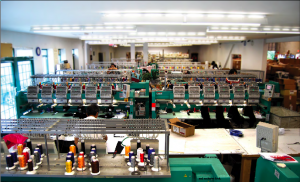Custom Screen Printing Demystified Part II:
Continuing on with the Screen Printing process Part II of our series relays more information about
picking your design, styles of apparel and how these choices affect the costs for manufacturing.
Pricing of Apparel is based on four components.
Style – which apparel style you are ordering.
Quantity – the number of garments you order with the same design.
Colors – the number of colors in your design.
Locations – the amount and locations of printing on the garment.
Style of Garments:
Costs of Apparel varies by brand.
Pressing Media carries a wide selection, and sell to you for less than the MSRP.
We use our purchasing power to get you the best possible deal on all blank apparel by
transferring those savings into your project.
We stock American Apparel, Gildan, Alstyle, Apparel, Fruit of the Loom, Hanes, Nike, Ogio,
Big K, Red Kap, and can custom order nearly any brand. Specialty fabrics are also available in hemp,
organic cotton, and bamboo.
The color of shirts and sizes can also affect the cost of the garments.White and Black shirts are generally
less expensive than colored shirts. Also, sizes 2XL and above will increase the costs.
Quantity:
It’s simple mathematics:
Price $ = units/setup + screening costs.
As quantities increase, unit costs go down. It’s a matter of the set up time and production time divided
into the total quantity that goes on our presses. A larger quantity of single design will have a lower overall
unit cost compared to that of a minimum (12 items) quantity of a single design.
Colors:
Screen printing requires the creation of a separate screen for every color in your design. Colors are separated,
films are output and then the screens are created. The fewer colors in your design, the fewer films, screens and
expense for producing the design.
Separation types
Color separations for garment printing are generally divided into 3 types:
• Process color
• Simulated process
• Spot color
Locations:
Each print location on a piece of apparel (i.e. Center Chest, Center back, Lapel. Sleeve, etc.) requires it’s own set of films and screens to manufacture. So having multiple print locations on your apparel will be reflected in the price per unit.
Personalization – adding individual names and/or numbers will increase the cost of your shirts as well.
Some methods of lowering the cost of apparel:
** Print on white shirts
** Use fewer design colors:
** Increase the quantity/order size:
** Decrease printing locations
Types of Apparel Printing
Traditional screen printing:
Screen-printing is one of the more versatile printing formats using ink blocking stencils and mesh screens to create a design. Specialty effects can be used to fashion various outcomes, and color can also be matched to any pantone. There are also numerous techniques available that can add additional texture to your printed designs. Some of the screen printing we
do include athletic-paint for dry-fit and lycra garments, discharge effects, glitter, foiling, gel, high density, metallic, plastisol, waterbase and so forth.
Embroidery
Traditional embroidery will always be one of the more popular solutions when decorating because of its versatility. Our digitizing department hosts a team of efficient experts, providing our customers with turnaround times
as fast as overnight. Our in-house production workers have years of experience creating unique
embroidered finishing, such as reflective embroidery, motif embroidery, 3D Puff embroidery, gradient blends, photo embroidery, appliqué and so forth. Encapsulating a brand in an embroidered logo boasts a professional
and exclusive look.
Direct-to-garment
Direct to garment was developed to fill in the gaps left by the other garment decoration methods. For example, embroidery doesn’t allow for photographic detail. Screen printing multiple colors is extremely expensive and requires high minimum order quantities due to the high set-up costs of each image. Heat transfers deliver a thick, rubbery feel to the graphic. Dye sublimation is appropriate only for 100% synthetic fabrics. With direct to garment printing, each image prints digitally (similar to a paper printer), so there is no screen making, no messy clean up, and no color or minimum quantity limitations.
Heat transfer –
Our graphic designers will help you smoothly transition your artwork and logo into transferable films. You can choose from multi-colored films, neon films, glow in the dark films, 3D reflective films and much more. Orders less than 6 pieces, or requests that require many different colors, where the cost to set up multiple screens for traditional printing is greater than the cost of heat transfer printing.
We hope that this blog has increased your understanding of how Apparel printing works, and helps in
submitting proper artwork, to avoid delays and maximize cost savings on your project.
Screen Printing Demystified Part II will explain how colors , placement and apparel style affects the costs in more depth.
For more information or a custom quote please feel free to contact us at 1-800-511-8171 ext 101 or
sales@pressing-media.com









